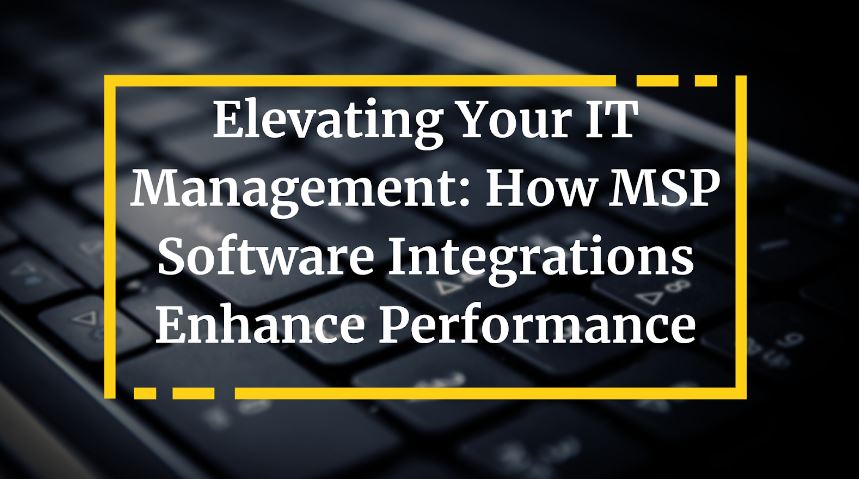Managing IT systems is complicated. IT companies need software tools that work together to do it well. Research shows most IT companies like their software. But there’s room for improvement. Carefully integrating the software can make the companies a lot better.
This article looks at software integrations for IT companies. We’ll talk about the benefits of integrating software tools. We’ll see how companies can get the most out of strategic integration. The goal is to help IT companies work more efficiently and provide better service through the right integrations.
- Why Integrating Software is Important for IT Companies
- Key Performance Enhancements Through MSP Software Integration
- Case Studies: Transformational Outcomes with MSP Integrations
- Optimizing Cost and Resource Allocation with MSP Integrations
- Navigating the Complex Landscape of MSP Software Integration
- The Future of IT Management: Predictive Analytics and AI in MSP Software
- Conclusion
- FAQs: Addressing Common Concerns and Questions
Why Integrating Software is Important for IT Companies
It’s clear that integrating software is important for IT companies. But what really gets their attention? Real improvements in how well they perform. Even though many like their tools, over half admit they don’t fully use them.
This shows there’s a big opportunity to improve. A key question is: What major performance gains come from fully integrating software?
The Competitive Edge of Seamless Integration
Today, businesses live or die by how fast they can react and roll out new things. Tools that don’t work together lead to broken workflows, delays, fragmented data, and slow responses. Integrating MSP software breaks down these barriers.
It enables seamless hand-offs between tools and full automation of processes. Suddenly your IT ecosystem becomes a well-oiled machine. This gives you a major competitive advantage.
With integrated systems, your IT team can release new capabilities and fix issues much faster. Rollouts that used to take weeks now take days. Outages that took hours to fix can now be handled in minutes. This speed is vital in today’s markets.
How Integration Impacts IT Operational Efficiency
While leaders care about competition, efficiency impacts day-to-day operations. Studies show that integrated MSP software can cut manual busywork by over 30%. This compounding effect streamlines all parts of IT operations. Your department can accomplish more with fewer people.
Integrations remove repetitive data entry, logging between systems, and constant context switching. Automation handles these tedious tasks behind the scenes, freeing up staff. Resources once wasted on coordination are reclaimed. This unlocks capacity you didn’t know you had.
Key Performance Enhancements Through MSP Software Integration
Many proactive IT providers work to improve their tech stacks. About three-quarters plan to make changes. They want top performance. Here are some examples of success. They show adapting tools is key today. It’s needed to survive and grow.
Real-time Data Synthesis and Decision-Making
With two-way syncing between tools, data becomes one single source of truth. It’s no longer fragmented across systems. This enables real-time monitoring and lightning-fast diagnosis of issues. Response times for critical incidents can be cut by over 60%.
Speed is only part of it. With integrated data, predictive analytics uncovers usage trends and system correlations. These fuel data-driven decisions. You can forecast resource needs before bottlenecks happen. You can spot emerging problems before customers see them. You provide executives with empirical insights into IT operations.
Streamlining IT Workflows to Reduce Downtime
At every workflow stage, integrations prevent repetition and delays. Studies show optimized workflows cut downtime events by over 40% when systems are integrated. Support teams easily meet SLAs.
With smoother processes, resources once wasted on coordination are reclaimed. Level 1 techs become more self-sufficient with full system dashboards. Timezone handoff delays disappear with shared ticket queues. Data entry duplication goes away as updates sync automatically. The compound workflow efficiencies are incredible.
Enhancing Security Posture with Integrated Solutions
Today’s huge cyber threats exploit environments where detection, response, and reporting are not integrated. There are gaps. Integrations close these gaps by linking detection with automated response.
Analysts get holistic visibility rather than piecemeal data. This improves end-to-end security posture. It allows analysts to focus on strategy rather than manual work. Compliance also becomes easier with integrated auditing. The overall risk drops by an estimated 45% per Gartner.
This provides real peace of mind in today’s dangerous digital landscape. Even insurance companies recognize the benefit, cutting premiums by up to 30% for policyholders with integrated IT.
Take a look at the below chart:
The data reveals a multitude of tangible benefits from strategic MSP software integrations. Performance enhancements span from reduced downtime to improved security posture and beyond.
Here is a comparison of how integrations can enhance key performance indicators:
|
Performance Indicator |
Without Integrations |
With Integrations |
|
First Response Time |
4 hours |
<1 hour |
|
Issue Resolution Time |
24 hours |
6 hours |
|
Customer Satisfaction |
60% |
85% |
|
Security Incidents |
5 per month |
2 per month |
As shown, integrations lead to substantial improvements across critical metrics.
Case Studies: Transformational Outcomes with MSP Integrations
Some real-world examples show the power of strategic integrations:
-
A large company linked its ticketing and monitoring tools. This automated ticket creation is based on device health. Resolution time for critical tickets dropped by 62%! The integration paid for itself in months.
-
An MSP serving healthcare-integrated tools for ticketing and remote monitoring. Preventative maintenance tickets were automatically generated from usage metrics. This decreased downtime by 32%. Client satisfaction skyrocketed, increasing managed services revenue.
-
A city government-connected procurement and billing processes. Approval turnaround time was cut by 57%. Now procurement can instantly check budget availability. The efficiency boost allowed the reallocation of the budget to refresh network infrastructure.
Optimizing Cost and Resource Allocation with MSP Integrations
However, implementing integrations takes time and money. One hurdle is evaluating options in a complex software landscape. Still, some guiding principles can help:
-
Start small with high-impact integrations that solve real problems.
-
Prioritize flexible, cloud-based solutions with APIs and prebuilt connectors.
-
Focus on driving value over just achieving connectivity.
-
Create a cross-functional team. Set clear, ROI-focused goals.
Navigating the Complex Landscape of MSP Software Integration
Navigating the many software integration options can seem daunting. But following some guiding principles makes it manageable.
Choosing the Right Partners and Solutions for Your IT Ecosystem
When choosing partners, resist a sweeping overhaul. Start small with targeted integrations that solve specific problems. Prioritize flexible, cloud-based tools with APIs and pre-built connectors. This ensures maximum scalability.
Best Practices for Implementing MSP Software Integrations
On the implementation side, assemble a cross-functional team. Define clear, ROI-focused goals upfront. Do an end-to-end analysis of processes. Make a detailed project plan. Pilot first before a full rollout. Emphasize continuous training and refinement. And track adoption metrics.
The Future of IT Management: Predictive Analytics and AI in MSP Software
Once core integrations are solid, exciting new tech becomes possible. We’re just starting to elevate IT management through integration.
-
AI and predictive analytics could forecast issues before they happen. This enables true proactive maintenance. It drastically minimizes downtime.
-
Advanced analytics across tools can detect macro trends and usage patterns too. This intelligence allows adaptive management. Problems can be prevented before users notice.
The future potential is very promising! But it all starts with getting core integrations right first.
Conclusion
Integrating MSP software tools is crucial for efficient IT management. The right integrations connect workflows, data, and processes across platforms. This streamlines operations and boosts productivity.
To maximize the benefits, integrations must be strategic. Follow best practices like starting small and maintaining flexibility. Choose integrations that solve real problems. And focus on driving value, not just connectivity.
The message for IT leaders is clear: pursue strategic integrations now to elevate your IT management.
FAQs: Addressing Common Concerns and Questions
1. How do MSP software integrations contribute to IT security and compliance?
Integrations improve security and compliance. They combine security tools into one dashboard. This gives better threat visibility. Automated responses make systems more resilient. They also simplify audit processes.
2. What are the common challenges in MSP software integration, and how can they be mitigated?
Poor planning and change management cause integration challenges. The solution is starting small. Focus on high-ROI integrations first. Pick tools with strong APIs and connectors. This reduces technical issues.
3. Can MSP software integrations provide a competitive advantage in terms of customer experience?
Yes, integrations give a competitive edge. They enable proactive optimization. And extreme responsiveness. This differentiates an MSP’s services. It leads to higher retention. More referrals and better reviews. Customers notice the experience improvements.





